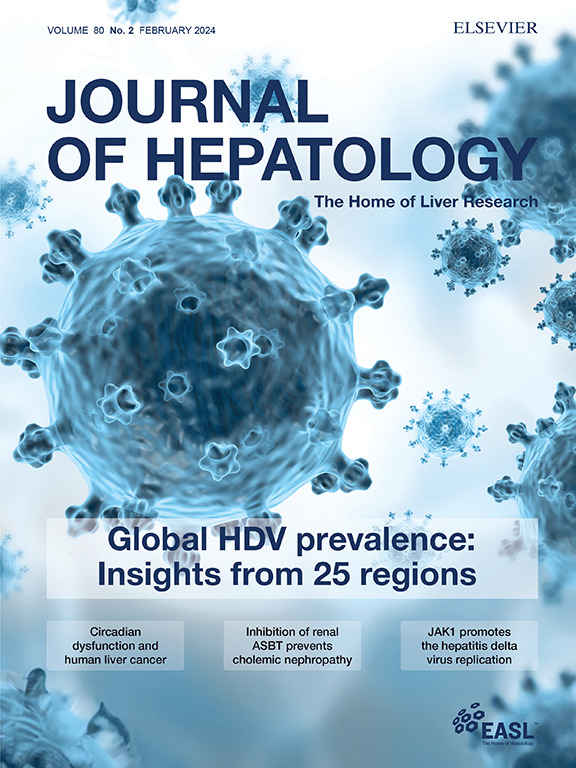Validation and expansion of Baveno VII recompensation criteria in patients with cirrhosis and curable liver disease
IF 26.8
1区 医学
Q1 GASTROENTEROLOGY & HEPATOLOGY
引用次数: 0
Abstract
Background and Aims
Baveno-VII consensus recently defined recompensation in patients with decompensated cirrhosis achieving etiological cure. However, incidence, predictors and clinical significance of recompensation are poorly known. This study aimed to evaluate the incidence and prognostic impact of recompensation in patients with decompensated cirrhosis.Methods
Outpatients with cirrhosis and curable etiologies (alcohol, HCV, HBV) were consecutively included and followed up. Recompensation was defined according to Baveno VII criteria. Additionally, expanded recompensation criteria were evaluated for patients on low dose diuretics and/or lactulose/rifaximin for ≥12 months. In 160 patients, inflammatory cytokines (IL-6,IL-1β, IL-10) were measured in serum samples. An external cohort was used to validate study findings.Results
298 out of 525 decompensated cirrhotic outpatients achieved an effective etiological treatment and 21 (7%) achieved recompensation (Baveno-VII criteria), while 112 patients achieved expanded recompensation criteria (37.6%). MELD score (sHR=0.89; p<0.001), BMI (sHR=0.93; p=0.020), hemoglobin (sHR=1.14; p=0.010) and further decompensation (sHR=0.50; p=0.001) were independent predictors of recompensation. In multivariable analysis, mortality risk was not significantly different between patients achieving recompensation and compensated patients (HR=0.97; p=0.947), while decompensated patients had the highest mortality risk (HR=4.96; p<0.001). Mortality risk was not significantly different between patients meeting expanded recompensation criteria and Baveno-VII criteria (HR=0.97; p=0.938). Serum IL-6, IL-1beta and IL-10 were significantly higher in decompensated patients than in compensated and recompensated patients.Conclusion
Baveno-VII criteria identify cirrhotic patients with a good prognosis, but fewer than 10% of decompensated patients achieve recompensation. Expanding these criteria to include patients receiving minimal decompensation treatment identifies those with similarly low mortality risk.Impact and implications
In recent years, growing evidence has shown that achieving an etiological cure can significantly improve the prognosis of decompensated patients, leading to the development of the concept of recompensation. Baveno VII recently proposed a definition for recompensation; however, data on the clinical impact of this condition remain limited. In this study we evaluated Baveno VII criteria and developed and validated expanded Baveno VII criteria for recompensation. Our findings demonstrates that recompensation is associated with improved survival, reduced hyperdynamic circulation and decreased systemic inflammation in outpatients with decompensated cirrhosis. These results are valuable for hepatologists and researchers aiming to refine patient management strategies and risk stratification in cirrhosis care.

肝硬化和可治愈肝病患者的Baveno VII再补偿标准的验证和扩展
背景和目的最近,Baveno-VII 共识将病因治愈的失代偿期肝硬化患者定义为再代偿。然而,人们对再代偿的发生率、预测因素和临床意义知之甚少。本研究旨在评估失代偿期肝硬化患者再代偿的发生率和对预后的影响。方法连续纳入并随访肝硬化且病因可治愈(酒精、HCV、HBV)的患者。根据巴韦诺 VII 标准定义失代偿。此外,还对使用小剂量利尿剂和/或乳果糖/利福昔明≥12 个月的患者进行了扩大的恢复标准评估。对 160 名患者的血清样本中的炎症细胞因子(IL-6、IL-1β、IL-10)进行了测定。结果 525 例失代偿期肝硬化门诊患者中,298 例获得了有效的病因治疗,21 例(7%)获得了肝功能恢复(Baveno-VII 标准),112 例患者达到了扩大的肝功能恢复标准(37.6%)。MELD 评分(sHR=0.89;p<0.001)、体重指数(sHR=0.93;p=0.020)、血红蛋白(sHR=1.14;p=0.010)和进一步失代偿(sHR=0.50;p=0.001)是再代偿的独立预测因素。在多变量分析中,获得再代偿的患者与代偿患者的死亡风险无显著差异(HR=0.97;p=0.947),而失代偿患者的死亡风险最高(HR=4.96;p<0.001)。符合扩大再补偿标准和 Baveno-VII 标准的患者的死亡风险无明显差异(HR=0.97;p=0.938)。失代偿患者的血清 IL-6、IL-1beta 和 IL-10 明显高于代偿和再代偿患者。影响和意义近年来,越来越多的证据表明,实现病因治愈可显著改善失代偿患者的预后,从而提出了再补偿的概念。Baveno VII 最近提出了失代偿的定义;然而,有关这种情况的临床影响的数据仍然有限。在这项研究中,我们评估了巴韦诺七世的标准,并制定和验证了巴韦诺七世关于再代偿的扩展标准。我们的研究结果表明,失代偿肝硬化门诊患者的再代偿与生存率的提高、高动力循环的减少和全身炎症的减轻有关。这些结果对肝病专家和研究人员在肝硬化治疗中完善患者管理策略和风险分层很有价值。
本文章由计算机程序翻译,如有差异,请以英文原文为准。
求助全文
约1分钟内获得全文
求助全文
来源期刊

Journal of Hepatology
医学-胃肠肝病学
CiteScore
46.10
自引率
4.30%
发文量
2325
审稿时长
30 days
期刊介绍:
The Journal of Hepatology is the official publication of the European Association for the Study of the Liver (EASL). It is dedicated to presenting clinical and basic research in the field of hepatology through original papers, reviews, case reports, and letters to the Editor. The Journal is published in English and may consider supplements that pass an editorial review.
 求助内容:
求助内容: 应助结果提醒方式:
应助结果提醒方式:


